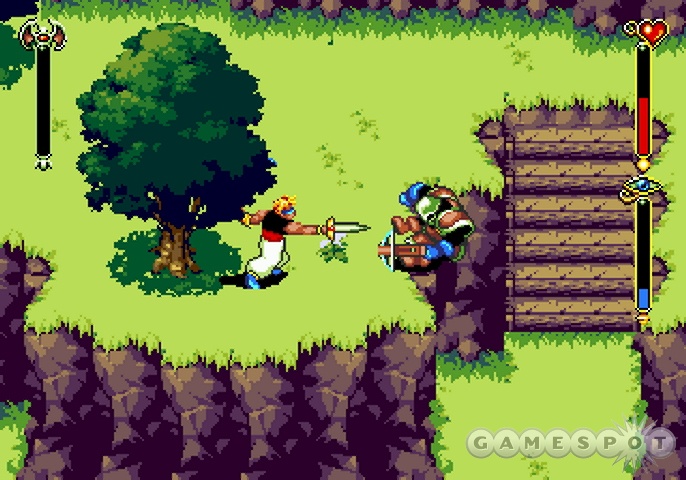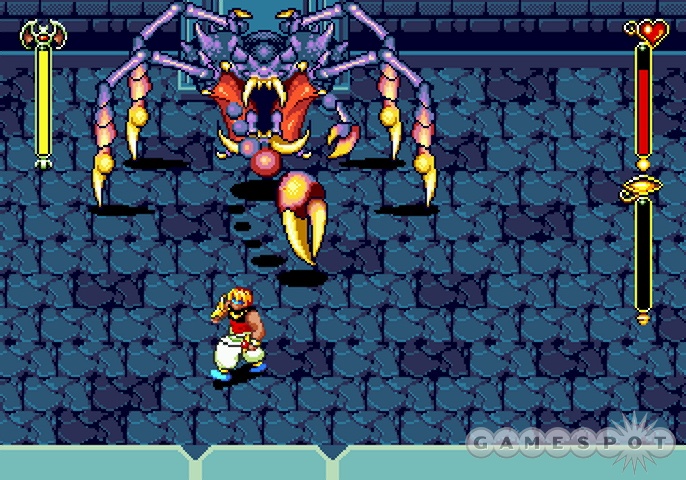Beyond Oasis (known in Japan and Europe as The Story of Thor) is the Sega Genesis console's answer to The Legend of Zelda. If you've just recently become aware of it, that's not surprising. It was originally released back in December of 1994, when the Sega Genesis was on its last legs. On top of that, Sega hasn't included Beyond Oasis in any of the company's various classics compilations over the years, which means that the Wii's Virtual Console shop is the only opportunity most people have had to own and play the game since its original release.

A good way to describe Beyond Oasis is that it's a more combative take on The Legend of Zelda. You play as Ali, a young adventurer that found a magical gold armlet while searching a cave one day. He's then tasked with collecting the four elemental spirits necessary to stop the bad guy that's been unleashing all sorts of nasty monsters on the land of Oasis. As you travel around the overworld and make your way through the various dungeons scattered around Oasis, you'll fight monsters in real time, solve a myriad of switch-based puzzles, and collect a multitude of weapons and objects that will help you on your quest. The action is presented from an isometric-style top-down viewpoint, and combat mainly involves fighting individual monsters with whatever swords, crossbows, or bombs you happen to have handy. Besides walking around and stabbing things, you can make Ali run, jump, and perform different sword attacks. You can also use his armlet to summon and command the different elemental spirits that you collect during the quest. Once summoned, a spirit will follow you around, reveal secrets, and attack enemies until your magic counter is depleted. On the whole, you'll spend much more time fighting than you will exploring or solving puzzles, though the puzzles and bosses in each dungeon certainly do require you to put all of Ali's abilities to use.
After all these years, the game still looks nice. The 2D graphics are roughly comparable to what you'll find in The Legend of Zelda: A Link to the Past on the Super Nintendo. Thanks to the isometric viewpoint and a masterful use of shading, the environments convey a three-dimensional sense of proportion and depth. You can climb up stairs, jump off of ledges, and splash around in shallow ponds. Decorative details, such as waterfalls and leaping fish, also help bring the world of Oasis to life. Ali and the various enemies are large and fluidly animated. At the end of each dungeon, you'll encounter a giant spider, a massive dragon, or some other boss that occupies at least half the screen and usually stretches far off into the distance. The game's sound effects consist of generic slashes and clangs, along with a few grunts and growls here and there. The music isn't composer Yuzo Koshiro's best work, but the medieval anthems he concocted set the appropriate mood. For the Wii's part, the system has no trouble emulating the graphics and audio exactly as they'd be on an actual Sega Genesis console.

Beyond Oasis moves along at a brisk pace. There's not much backtracking, the map always points you to the next objective, and some events will whisk you to the next region of the island without forcing you to walk there. As a result, the game doesn't have many dull moments. However, because you don't have to waste time exploring, the quest doesn't take very long to complete. Your first time through may take about eight hours, and subsequent plays will require half that. The game provides four slots for saves and ranks your best times. In 1994, its $50 price tag might have been hard to swallow given the quest's brief length. Now that the game costs 800 Wii points ($8) from the Wii's Virtual Console shop, the price seems about right. You probably won't mind forking over the cash if you've been looking for a game like The Legend of Zelda that's not so much about wandering the countryside as it is slaughtering hordes of ugly monsters.